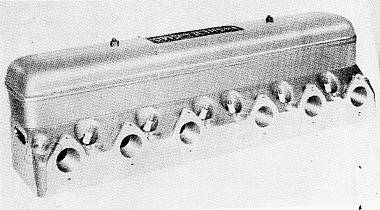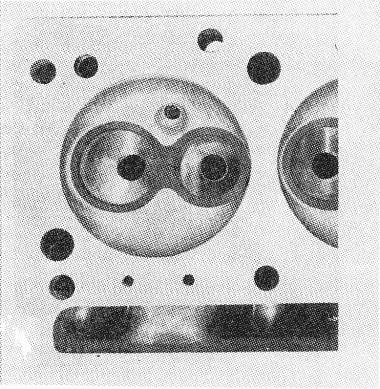Back in Issue #2, we mentioned that when Wayne F.
Horning moved on from the 12 port cylinder head business, he sold to two well-known
Chevy/GMC speed merchants of that day. One of these gentlemen was Calif. Bill
Fisher. It was Bill Fisher who bought the patterns and blueprints for the Horning 12
Port GMC cylinder head. This was in late 1951 or early 1952.
Calif. Bill Fisher is now more commonly
referred to as Mr. Fred W. Fisher, the President of HP Books, of Tucson, Arizona. HP
Books publishes, among other fine works, such well known books as the series on Holley and
Rochester carbs, Chevy engines and Turbochargers, all of which are generally familiar to
all rodders.
During the approximately four years that Calif.
Bill was in the business of producing 12 Port GMC cylinder heads, his total production was
not too extensive. Upon obtaining the blueprints and patterns (or if you refer, the
molds) from Wayne Horning, Fisher cast his first 12 Ports in cast iron. These were
made oat a foundry in Exeter, California. This continued the use of cast iron which
had been used exclusively by Wayne Horning. Calif. Bill estimates that he cast three
of four heads in cast iron. At that point, he decided to switch to aluminum for the
12 port heads. The remainder of his production was done in aluminum. His
estimates of the production total of aluminum heads ranges from 6 to 20, with around a
dozen being the best estimate. Perhaps there were as many as 20, but about 12 is a
best guess.
Bill Fisher had the aluminum heads cast at a
foundry in Los Angeles and they were done in 356 T-6 heat treated aluminum and weighed
approximately 32 lbs. apiece. While the cast iron heads that Fisher produced were
exactly the same as those done by Wayne Horning, this new move into the use of aluminum
followed the lead of others such a Howard Johansen, whose 12 port aluminum head for GMC
was on the market in April 1952, and was also done in 356 heat treated aluminum. A
major design change that Bill Fisher made was to begin using ling reach spark plugs,
thereby elimination the cartridge-fire, and seal type of spark plugs that Wayne Horning
had employed. The Fisher heads still used lightened 1 7/8 inch intake valves and 1
5/8 inch exhaust valves, the same size Horning had used. The valve seats in the
Fisher head were made from cast iron, were of the figure eight type, and were
positioned in the head at the time of casting. He also utilized new one piece
precision-machined valve guides to restrict valve movement. He continued to produce
the special billet cams that were necessary due to the special valve layout that continued
the design of Wayne Horning. That design, being a layout with an intake valve on
each end and two exhaust valves side by side, in the middle. While the aluminum
heads were highly resistant to electlitic action between the cast iron block and the
aluminum head, Calif. Bill further instructed buyers to coat each side of the stock head
gasket with aluminum paint and to paint the water jacket areas also. He also
provided tubular pushrods, shortened to fit and assembled. He was also very
insistent about installing the Champion spark plug with a torque wrench, set at 25 lbs.
maximum.
Another fine piece of equipment that Bill
Fisher continued to produce was the two piece aluminum valve covers, the bottoms of
which were attached to the head to prevent spilling oil when adjusting the lifters.
"I used up any 'Wayne F. Horning' valve covers which I obtained form Wayne
Horning. Then we made some that said 'Fisher'." These later types, with
"Fisher-GMC" on them are perhaps the most common type.
Among Bill Fisher's customers were such well
known and legendary racers as Rolla Vollstedt and Hoy Stevens. In 1956, Hoy Stevens,
of Fredericktown, Ohio, bought out Bill Fisher and obtained from him the patterns (molds)
and blueprints for the Horning-Fisher 12 port cylinder head as well as the patterns for
the two piece valve cover, and all the remaining stock that Calif. Bill had on hand.
We'll talk about Hoy Stevens in a future installment, as the story goes on.
Bill Fisher then went on to work for Ampex Corp., manufacturers of magnetic tape
recorders, as their advertising manager, in Redwood City, California. In 1965, he
founded HP Books, where he is still happily at work today.
The total production of Horning-Fisher 12
port heads was between 25 and 30; thirteen to sixteen of those were cast iron, 10 to 12
being cast by Wayne Horning and 3 of 4 by Bill Fisher. The remainder, 6 to 20 were
cast in aluminum by Bill Fisher. However, production did continue under the guidance
of Mr. Hoy Stevens, a part of the story we will attempt to cover in our next issue.
Mr. Fred W. Fisher, publisher, and President
of HP Books, is still an avid hot rodder. His car holds the current Bonneville
record in C Gas Coupe, at 203.686 mph, set in 1978, and also the record for C Altered
Coupe at 208.471 mph, also set in 1978. A recent letter from Mr. Fisher indicates
that he will be back on the salt this Fall taking a shot at the C Production Coupe record
of 197.763 mph, set in 1975 by LeVan Prothero. Mr. Fisher mentioned in his letter
that two years ago they had a number of runs that surpassed this record, but they were
unable to put together the required number of back to back runs to establish a new record,
due to clutch problems and a 5 speed that didn't want to shift too well. Ah, the
same problems as all the rest of us regular rodders have.
Calif. Bill Fisher, is a name synonymous
with GMC/Chevy racing and high performance. He is somewhat of a legend in his own
time. His contributions speak for themselves and all of us here at "12 Port
News" are certainly pleased to have him as our new friend, and to wish him well in
all he does.
 |
The aluminum 12 port cylinder head
for GMC produced by Calif. Bill
Fisher. Weight: 32 lbs. |
| A close up of the combustion chamber of the aluminum Fisher 12 port
head for GMC. The figure 8 style cast iron valve seats were positioned at casting
and will not come out. |

|